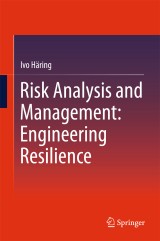Details

Risk Analysis and Management: Engineering Resilience
|
96,29 € |
|
| Verlag: | Springer |
| Format: | |
| Veröffentl.: | 19.02.2016 |
| ISBN/EAN: | 9789811000157 |
| Sprache: | englisch |
Dieses eBook enthält ein Wasserzeichen.
Beschreibungen
The book introduces basic risk concepts and then goes on to discuss risk management and analysis processes and steps. The main emphasis is on methods that fulfill the requirements of one or several risk management steps. The focus is on risk analysis methods including statistical-empirical analyses, probabilistic and parametrized models, engineering approaches and simulative methods, e.g. for fragment and blast propagation or hazard density computation.<br>Risk management is essential for improving all resilience management steps: preparation, prevention, protection, response and recovery. The methods investigate types of event and scenario, as well as frequency, exposure, avoidance, hazard propagation, damage and risks of events. Further methods are presented for context assessment, risk visualization, communication, comparison and assessment as well as selecting mitigation measures. <br>The processes and methods are demonstrated using detailed results and overviews of security research projects, in particular in the applications domains transport, aviation, airport security, explosive threats and urban security and safety. Topics include: sufficient control of emerging and novel hazards and risks, occupational safety, identification of minimum (functional) safety requirements, engineering methods for countering malevolent or terrorist events, security research challenges, interdisciplinary approaches to risk control and management, risk-based change and improvement management, and support of rational decision-making.<br>The book addresses advanced bachelor students, master and doctoral students as well as scientists, researchers and developers in academia, industry, small and medium enterprises working in the emerging field of security and safety engineering.
Introduction, overview and acknowledgements.- Introduction to risk analysis and risk management processes.- Introduction to database analysis of terroristic events.- More elaborate database analysis.- Event analysis: initial situation and hazard source.- Hazard propagation I: Explosions.- Hazard source characterization and propagation II: fragments.- Hazard propagation III: Free field blast and complex blast: empirical-analytical expressions and scaled experiments.- Mathematical basics for damage analysis.- Damage Analysis I: Probit functions and probability distributions.- Damage Analysis II: Selection of distributions and determination of parameters.- Damage analysis III: Presented surfaces.- Risk computation and visualization.- Simple examples of risk analysis.- Risk analysis in an example of harbor security.- Risk acceptance criteria.- Further Reading: Risk assessment, evaluation and communication.- Mitigation measures
<div>Ivo Häring received a PhD in physics at the Max-Planck-Institute for Complex Systems (MPIPKS) from the Technical University Dresden (TUD). Since 2004 he works at the Fraunhofer Ernst-Mach-Institute (EMI), Germany; currently as deputy head of the department Safety Technologies and Protective Structures, head of the group Resilience Engineering and as senior scientist for the Safety and Efficiency Analysis group, the Reliable Systems group and the Hazard and Risk Analysis group. Areas of interest include: qualitative and quantitative risk and resilience analysis, engineering, management, and optimization; system modelling, analysis, engineering and numerical simulation; technical reliability and safety analysis of multi-domain systems including software and networks; and software application and 3D expert tool development. In these areas he contributed to the scientific work program, execution and dissemination of multiple national and EU funded research projects, in particular withthe aims of risk control, susceptibility and vulnerability reduction as well as resilience enhancement. The results have been documented in many (conference) articles and used for lectures within safety and security engineering degree programs and continuous academic courses for resilient technical systems. He is member of the editorial board of the European Journal for Security Research (EJSR).</div><div><br></div>
The book introduces basic risk concepts and then goes on to discuss risk management and analysis processes and steps. The main emphasis is on methods that fulfill the requirements of one or several risk management steps. The focus is on risk analysis methods including statistical-empirical analyses, probabilistic and parametrized models, engineering approaches and simulative methods, e.g. for fragment and blast propagation or hazard density computation.<br>Risk management is essential for improving all resilience management steps: preparation, prevention, protection, response and recovery. The methods investigate types of event and scenario, as well as frequency, exposure, avoidance, hazard propagation, damage and risks of events. Further methods are presented for context assessment, risk visualization, communication, comparison and assessment as well as selecting mitigation measures. <br>The processes and methods are demonstrated using detailed results and overviews of security research projects, in particular in the applications domains transport, aviation, airport security, explosive threats and urban security and safety. Topics include: sufficient control of emerging and novel hazards and risks, occupational safety, identification of minimum (functional) safety requirements, engineering methods for countering malevolent or terrorist events, security research challenges, interdisciplinary approaches to risk control and management, risk-based change and improvement management, and support of rational decision-making. <br>The book addresses advanced bachelor students, master and doctoral students as well as scientists, researchers and developers in academia, industry, small and medium enterprises working in the emerging field of security and safety engineering.
Introduces basic risk concepts and risk management, as well as modular analysis processes and steps Offers engineering and technology methods that fulfill the requirements of one or several risk management steps Focuses on statistical-empirical analyses, probabilistic and parametrized models and engineering approaches Presents examples with detailed results and overviews of security research projects Takes account of the societal and decision making context for improving resilience Modular approach applicable for different types of hazards: natural and man-made, accidental and malevolent Method toolbox can be tailored to available resources Includes supplementary material: sn.pub/extras
Diese Produkte könnten Sie auch interessieren:

System Signatures and their Applications in Engineering Reliability

von: Francisco J. Samaniego

96,29 €















